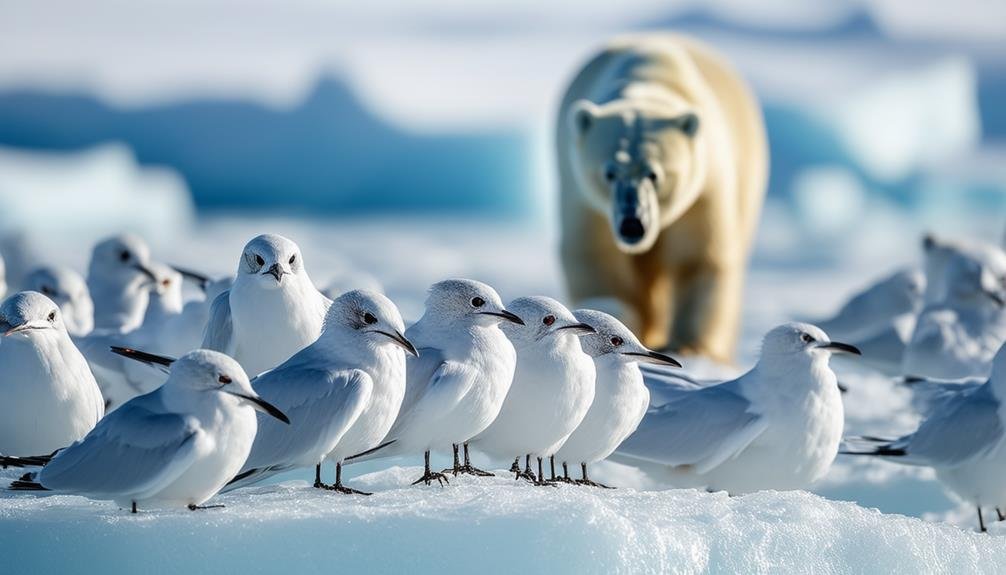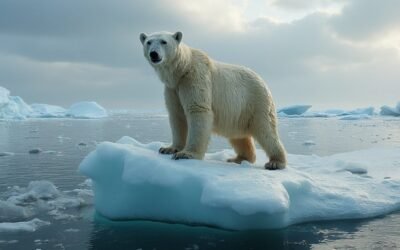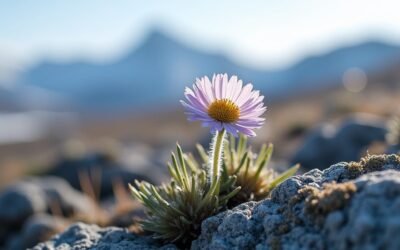Climate change profoundly alters the lives of polar avians. You'll find their habitats shrinking as sea ice recedes and temperatures rise, leading to less food and increasing predation risks. These birds face disrupted migratory patterns and breeding cycles, often laying eggs earlier or in misaligned seasons. Food scarcity becomes a more pressing issue as the availability and type of prey change. Diseases and parasites flourish in warmer temperatures, posing additional threats. On a broader scale, declining populations and reduced genetic diversity also hinder their ability to adapt to new environmental challenges. Exploring further might reveal more about how these impacts intertwine.
Main Points
- Climate change causes habitat loss for polar avians due to receding sea ice and rising temperatures.
- Altered migratory patterns and phenological mismatches disrupt feeding and breeding times.
- Rising temperatures increase risks of disease and parasite spread among polar avian populations.
- Changes in prey distribution and abundance impact food availability for polar avians.
- Conservation efforts focus on monitoring changes and supporting polar avian populations through habitat protection.
Habitat Loss and Degradation
Climate change is significantly impacting the habitats of polar avians, leading to loss and degradation of their nesting and foraging areas. As you're delving deeper into this issue, it's essential to understand how the changing conditions are affecting these species. The receding sea ice and rising temperatures are more than just signs; they directly contribute to the significant reduction in resource availability that these birds depend on.
Loss of sea ice, in particular, stands out. It's not just about the ice itself disappearing; it's about what's beneath that ice. Marine ecosystems, which are vital to the food chain, are undergoing degradation. This affects the availability of prey for polar avians, disrupting their ability to feed and survive in their traditional habitats.
Furthermore, you've got to take into account the impact of coastal erosion and rising sea levels. These phenomena exacerbate habitat loss, literally washing away the areas where birds nest and feed. Coastal erosion strips away the physical environment, leaving less and less space for polar avians to call home.
As you see, the challenges are interconnected, with each element influencing the others, creating a cascade of environmental stressors that threaten the survival of polar avian populations.
Altered Migratory Patterns
As habitat loss disrupts polar avians, their migratory patterns are also undergoing significant alterations. You'll find that arctic terns, which typically traverse vast distances between their breeding and wintering grounds, are particularly impacted. Climate change is reshaping their migration routes and foraging areas, introducing critical challenges that could affect their survival.
The decline in North Atlantic primary production, a result of a fossil-fueled development scenario, directly threatens the foraging success of arctic terns during their long migratory journeys. This decline can lead to fewer food resources in traditional stop-over areas, such as the North Atlantic subpolar gyre and the Benguela upwelling system, which are essential for refueling.
Moreover, changes in the extent of sea ice and prevailing wind conditions in the Southern Ocean are altering the terns' migration routes. These alterations could force arctic terns to extend their already staggering annual journey, increasing their energy expenditure and reducing survival rates.
Phenological mismatches pose another critical challenge by disrupting the timing of food availability. As climate change impacts continue to unfold, the synchronization between the peak availability of prey and the terns' migration schedule is becoming increasingly misaligned, compounding the risks during their already perilous migrations.
Breeding Disruptions
Polar avians are now laying eggs noticeably earlier, by an average of 6.6 days per decade, in response to rising temperatures. This shift in timing, which you might find surprising, is part of a broader pattern of breeding disruptions affecting avian populations across North America and beyond.
As the planet warms, species like the Common Murre are advancing their breeding dates considerably—by as much as 24 days per decade. Similarly, North American Tree Swallows have started nesting up to 9 days earlier than they did three decades ago.
You're witnessing how avian species are scrambling to adjust their life cycles to match the pace of climate change. The earlier arrival of spring, a direct consequence of rising global temperatures, prompts birds to migrate sooner and start breeding earlier. However, these adaptations aren't just simple calendar shifts; they're a complex response to the changing environmental variables that dictate when and how these birds breed.
The challenge here is profound. As you observe these changes, consider the mismatch between birds' behaviors and the environmental cues they've relied on for millennia. This misalignment can lead to further complications in their breeding cycles, underscoring the intricate ways in which climate change is reshaping our natural world.
Food Availability Changes
While earlier breeding presents its challenges, changes in food availability further complicate survival strategies for polar avians. Climate change has been reshaping the landscape of food sources essential to these species. You'll find that the distribution and abundance of prey such as insects, fish, and plankton are shifting, driven by alterations in plant phenology and sea temperatures. These shifts aren't just minor adjustments; they represent significant transformations in the ecosystems that polar avian species rely on.
As a result, you're seeing disruptions in food chains that affect the population dynamics of these birds. Variability in food availability forces polar avians to alter their foraging behaviors and dietary preferences, which can lead to a cascade of effects on their breeding success and overall survival. It's not just about finding food; it's about finding the right food at the right time, which is becoming increasingly difficult.
These changes in food availability are critical because they directly impact the health and viability of polar avian populations. As food sources become less predictable and more scarce, the challenge for these species to maintain their numbers and health intensifies.
Increased Predation Risks

Climate change-induced habitat alterations have heightened predation risks for polar avians. As you've seen, these birds now face unprecedented challenges due to the loss of sea ice and altered migration patterns. These changes expose them to new predators in their traditional breeding grounds, increasing the likelihood of encounters with species that were previously absent in these areas.
Habitat fragmentation has also played a significant role in this shift. It's not just about smaller, isolated territories; it's about how these fragmented landscapes make it easier for predators to access nests and vulnerable bird populations. This disruption in habitat not only exposes polar avians to heightened predation risks but also affects their breeding success.
Moreover, the shifts in predator-prey dynamics are a direct consequence of climate change. As the balance of these ecosystems is disrupted, predator species may move into new areas where polar avians haven't evolved defenses. This increases predation pressure and can drastically impact the survival rates of these avian species.
Understanding these dynamics is important. You must recognize that each of these factors—habitat fragmentation, altered predator-prey dynamics, and the broader effects of climate change—contributes significantly to the challenges faced by polar avians.
Disease and Parasite Spread
Rising temperatures not only melt ice but also foster the spread of diseases and parasites that threaten polar avians. As climate change progresses, you're seeing a concerning increase in the disease spread and parasite transmission among these vulnerable birds. Warmer conditions allow vectors like ticks and mites to thrive, greatly raising infection risks for polar birds.
These parasites, which were previously restricted by colder temperatures, are now finding a more hospitable environment in the Arctic and Antarctic regions. This shift not only affects the health of individual birds but also weakens entire avian populations, undermining their survival and ability to reproduce successfully.
Monitoring the dynamics of these diseases is essential. By understanding how climate change impacts the health of polar avians, you can develop strategies to mitigate these effects. It's not just about observing the changes; it's about actively responding to them to safeguard the survival of these species.
You're tasked with the responsibility to adapt conservation efforts to address these emerging challenges, protecting polar birds from the increasing threat of diseases and parasites exacerbated by the changing climate.
Phenological Mismatches

You must also consider how phenological mismatches, caused by climate change, disrupt the synchronization of migration and feeding times critical to the survival of polar avians. These mismatches occur when the timing of avian species' migration doesn't align with peaks in food availability, forcing birds to arrive too early or too late to find adequate nourishment. This disconnection can greatly heighten extinction risks for these creatures.
As rapid climate change progresses, the usual cues that trigger migration—such as temperature and daylight hours—alter unpredictably. For polar avians like the arctic tern, the lack of synchronization between their migratory schedule and the availability of prey along their route is exacerbated. This is due to their limited options for range expansion and slow genotypic adaptations to rapidly changing environments.
Conservation efforts now play a pivotal role in mitigating these risks. Strategies include monitoring phenological changes, adjusting protected areas, and possibly even intervening directly to support food sources along migratory paths. These measures are essential to make sure that polar avian populations can continue to thrive despite the challenges posed by climate-induced phenological mismatches.
Population Declines
Arctic tern populations are experiencing significant declines due to rapid climate change and the resulting phenological mismatches. As you explore further into the plight of these polar migrants, you'll find that their survival is increasingly jeopardized by the disruptions in their traditional life cycles. The mismatches affect when and where food sources are available, significantly impacting the terns' foraging capabilities.
The challenges don't stop there. The broader effects of climate change are reshaping the marine ecosystems that arctic terns depend on. Observations indicate a decline in North Atlantic primary production, a key source of nourishment for these birds during their long migrations. The reduction in food supply not only threatens their current populations but also their future generations.
Conservation efforts are now more essential than ever to curb these population declines. By addressing the adverse impacts of climate change and supporting resilient marine habitats, you can help guarantee that arctic terns and other polar avians continue to grace our skies. Remember, each action taken to mitigate these effects contributes to the survival of these remarkable migrants, preserving the delicate balance of our polar ecosystems.
Genetic Diversity Effects

Climate change's impact on polar avians extends to their genetic diversity, which is essential for adapting to shifting environmental conditions. As the planet warms, you'll find that the resilience of these species heavily depends on their genetic variability. This diversity is their toolkit for coping with changes and ensuring long-term survival.
Here's how genetic diversity influences polar avian species:
- Adaptation Capabilities: Greater genetic diversity allows for more robust adaptation strategies. Polar avians can adjust more effectively to rapid changes in their habitats, such as altered food sources and nesting grounds.
- Resistance to Threats: With more genetic variance, polar avians have a better chance of withstanding diseases and other environmental stresses. This reduces the risk of population declines due to health issues.
- Survival of Species: Ensuring a wide genetic pool is critical for the survival of these species under the pressures of climate change. It helps maintain population stability and resilience, reducing the likelihood of extinction.
You'll see that conservation efforts must prioritize maintaining this diversity. Without it, polar avians could lose their ability to cope with the new challenges posed by changing environmental conditions.
Conservation and Adaptation Efforts
Conservation and adaptation efforts are essential for mitigating the extinction risks faced by polar avians due to rapid climate change. You're at the forefront of implementing strategies that address the dire consequences of global warming on these species. By focusing on breeding programs and habitat conservation, you're helping to preserve the delicate balance of polar ecosystems.
The environmental changes brought about by climate change and global warming create phenological mismatches that can disrupt the breeding cycles of polar avians. Your role in adaptation strategies includes adjusting conservation practices to these new timelines, ensuring that avians have the resources they need at critical times.
Collaborative initiatives that you participate in, bringing together researchers, conservation organizations, and policymakers, are essential. These partnerships facilitate the development of climate-resilient management practices that are crucial for the avians' survival. By monitoring population trends and habitat changes, you're able to adapt your strategies in real-time, enhancing the effectiveness of your efforts.
Frequently Asked Questions
How Does Climate Change Affect the Arctic Birds?
You're likely wondering how climate change affects Arctic birds.
It disrupts their nesting, leading to habitat loss and food scarcity. These changes alter their migratory patterns and breeding cycles, causing thermal stress.
As Arctic terns struggle with these conditions, their survival becomes critical.
Understanding these impacts is vital for developing effective conservation strategies to protect these species and maintain the balance of marine ecosystems they rely on.
How Are Polar Species Affected by Climate Change?
You're seeing polar species grappling with climate change through various disruptions. Feeding patterns are altered, breeding timing is shifting, and habitats are fragmenting.
Additionally, migration routes are changing, diseases are spreading more widely, and predator-prey dynamics are becoming unpredictable.
These changes are critical; they not only threaten individual species with extinction but also destabilize the broader ecological networks that depend on these polar inhabitants for balance and health.
How Does Climate Change Affect the Avian Population?
As you navigate the shifting landscape of our planet, climate change profoundly affects avian populations. Migratory disruptions, habitat loss, and food scarcity are compelling birds to alter their breeding timing, which in turn affects disease spread and genetic diversity.
These changes may not always align with the environmental cues birds have historically relied on, leading to further challenges in their survival and reproduction strategies in an increasingly unpredictable world.
What Is the Impact of Climate Change on Polar Regions?
You're facing a world where climate change dramatically alters polar regions. Iceberg melting, glacial retreat, and permafrost thawing reshape landscapes, leading to habitat disruption.
Ocean acidification and rising sea levels further stress these fragile ecosystems. These changes disrupt not just the physical environment but also the living conditions for native species, escalating the urgency for global climate action to mitigate these impacts and preserve the unique biodiversity of polar regions.
How Do the Best Examples of Climate Change Impact Identified in Polar Birds Reflect Broader Effects on Polar Avians?
The best examples of climate change impact identified in polar birds reveal significant disruptions in migration patterns, breeding cycles, and food availability. These trends highlight broader climate impacts on polar birds, stressing the fragility of polar ecosystems and the chain reactions affecting species’ survival in a rapidly warming environment.
Conclusion
As you've seen, climate change profoundly affects polar avians, from shifting habitats to disrupted food chains. Isn't it important, then, to step up conservation efforts? By understanding and addressing these impacts, you can help mitigate the challenges these birds face.
Though the task is challenging, targeted conservation and adaptation strategies offer hope. Your awareness and action are essential in preserving the delicate balance of polar ecosystems. Remember, every effort counts in the fight against climate change.


